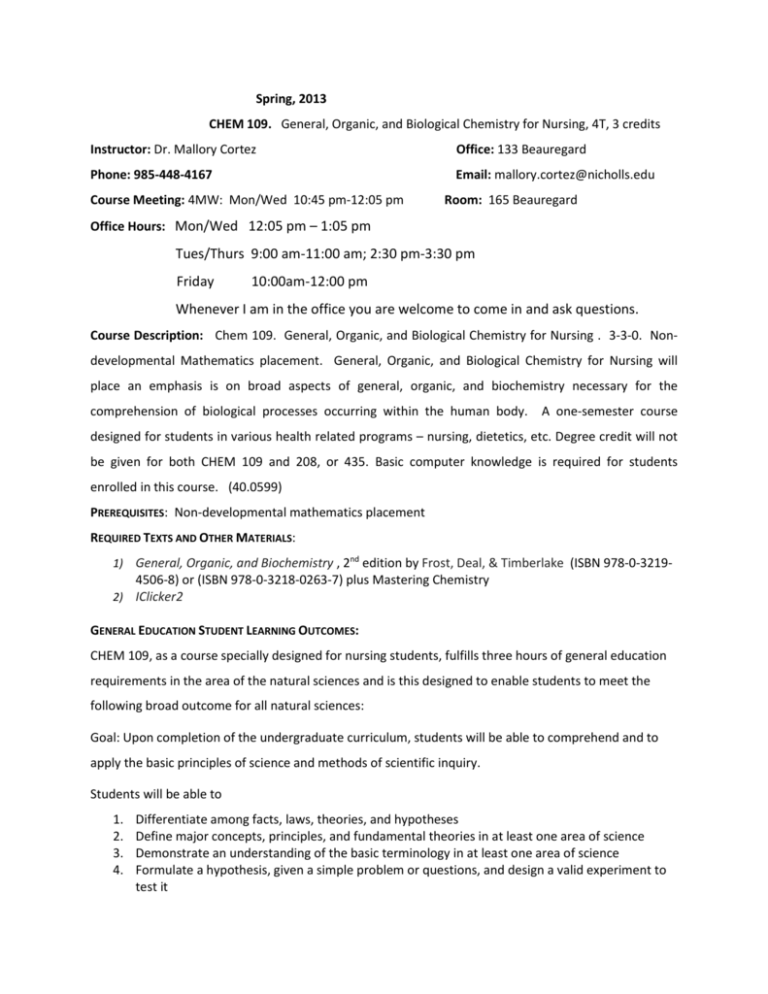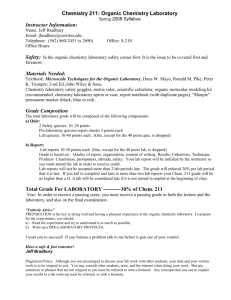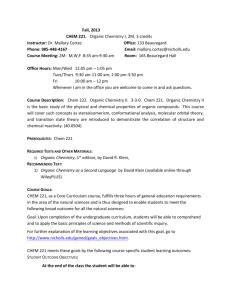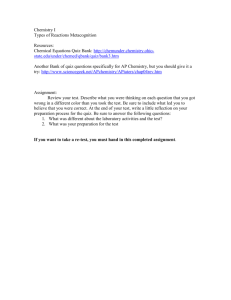Final Exam - Nicholls State University
advertisement

Spring, 2013 CHEM 109. General, Organic, and Biological Chemistry for Nursing, 4T, 3 credits Instructor: Dr. Mallory Cortez Office: 133 Beauregard Phone: 985-448-4167 Email: mallory.cortez@nicholls.edu Course Meeting: 4MW: Mon/Wed 10:45 pm-12:05 pm Room: 165 Beauregard Office Hours: Mon/Wed 12:05 pm – 1:05 pm Tues/Thurs 9:00 am-11:00 am; 2:30 pm-3:30 pm Friday 10:00am-12:00 pm Whenever I am in the office you are welcome to come in and ask questions. Course Description: Chem 109. General, Organic, and Biological Chemistry for Nursing . 3-3-0. Nondevelopmental Mathematics placement. General, Organic, and Biological Chemistry for Nursing will place an emphasis is on broad aspects of general, organic, and biochemistry necessary for the comprehension of biological processes occurring within the human body. A one-semester course designed for students in various health related programs – nursing, dietetics, etc. Degree credit will not be given for both CHEM 109 and 208, or 435. Basic computer knowledge is required for students enrolled in this course. (40.0599) PREREQUISITES: Non-developmental mathematics placement REQUIRED TEXTS AND OTHER MATERIALS: 1) General, Organic, and Biochemistry , 2nd edition by Frost, Deal, & Timberlake (ISBN 978-0-3219- 4506-8) or (ISBN 978-0-3218-0263-7) plus Mastering Chemistry 2) IClicker2 GENERAL EDUCATION STUDENT LEARNING OUTCOMES: CHEM 109, as a course specially designed for nursing students, fulfills three hours of general education requirements in the area of the natural sciences and is this designed to enable students to meet the following broad outcome for all natural sciences: Goal: Upon completion of the undergraduate curriculum, students will be able to comprehend and to apply the basic principles of science and methods of scientific inquiry. Students will be able to 1. 2. 3. 4. Differentiate among facts, laws, theories, and hypotheses Define major concepts, principles, and fundamental theories in at least one area of science Demonstrate an understanding of the basic terminology in at least one area of science Formulate a hypothesis, given a simple problem or questions, and design a valid experiment to test it 5. Make informed decisions on contemporary consumer or social issues demanding scientific literacy For further explanation of the learning objectives associated with this goal, go to http://www.nicholls.edu/gened/goals_objectives.html. STUDENT OUTCOME OBJECTIVES: This one semester course is designed to introduce students to the general principles of chemistry geared to the allied health major including organic chemistry and biochemistry. The principles fall into the four main areas of: 1. Measurement and Mathematical Concepts (MMC) 2. Molecular Structures (MS) 3. Solution and Acid/Base Chemistry (ABC) 4. Biochemistry (BC) Upon successful completion of this course, the student should be able to: Classify different forms of matter. Distinguish physical and chemical properties. Identify and describe the properties of metals and nonmetals (MS). Measuring items and applying rules for significant figures correctly (MMC). Convert English to metric units of measurement, and vice-versa. Perform simple dosage calculations through unit conversions (MMC). Explain the basic relationships of gas pressure, temperature, volume, and amount. Apply Boyle’s Law and Charles’ Law (MMC). Identify the number of subatomic particles present in atoms and ions. Distinguish between isotopes and ions by the number of subatomic particles present. Distinguish Mass Number from Atomic Mass (MS). Identify specific charges on ions. Distinguish and name ionic and binary covalent compounds. Identify the number of valence electrons in the main group elements (MS). Determine the molecular shapes of carbon, nitrogen, and oxygen in a covalent compound. Determine the polarity of the covalent bond and a covalent compound (MS). Distinguish representatives of organic compounds (including Lewis, condensed, skeletal, 3-D ball, and stick structures). Define structural isomer (MS). Recognize organic families and hydrocarbon functional groups (MS). Distinguish isomers of organic compounds as structural, cis/trans, enatiomers, and diastereomers. Identify chiral centers in organic molecules (MS). Identify a carbohydrate by its molecular formula and functional groups. Distinguish the simple sugars by structure and function (BC). Determine the ring structure of a linear monosaccharide. Recognize and name a glycosidic linkage. Identify the products of the following reactions for carbohydrates: condensation, hydrolysis, oxidation and reduction. Describe what is a reducing sugar (BC). Describe the structure and function of complex carbohydrates, and identify the corresponding glycosidic linkages (BC). Draw fatty acid salts in water, a “micelle”. Describe the difference between a saturated versus an unsaturated fatty acid. Draw a triglyceride, and identify its functional groups. Distinguish between a fat and an oil. Distinguish the structural differences between a triglyceride and a phospholipid. Identify the function of phospholipids. Draw a phospholipid bilayer (BC). Determine the direction of the flow of water across a membrane in osmosis and diffusion (ABC). Distinguish the three main mechanisms of transport across a biological membrane (BC). Distinguish between a solution and a suspension. Distinguish solutions as electrolyte, nonelectrolyte, or weak electrolyte (ABC). Calculate the concentration of a solution. Describe how you would make an aqueous solution of a known concentration using a solid solute or concentrated stock solution (ABC). Identify and learn how to name the strong acids and bases. Identify an acid, base, conjugate acid and conjugate base. Write conjugate acid-base reactions. Write a balanced neutralization reaction (ABC). Predict the strength of a weak acid from its Ka, or the pKa. Determine the acidity of a solution from the pH scale. Calculate the pH of a solution from its hydronium ion concentration and vice-versa (ABC). Explain how buffering works, and the components that make up a buffer. Apply LeChatelier’s principle to the bicarbonate buffer system (ABC). Determine the predominant species present in aqueous solution for the functional groups amine and carboxylic acid, found in amino acids, at a given pH (BC). Draw the general structure of an amino acid in zwitterion form. Identify the functional groups: amide, thiol, aromatic, and disulfide. Classify the amino acids by R- group polarity and charge (BC). Describe the levels of structure and various functions of proteins (BC). Establish whether a chemical reaction is exothermic or endothermic, by using a reaction free energy diagram. Apply the factors that affect enzyme activity to a given situation. Distinguish between competitive and noncompetitive types of inhibition (BC). Identify parts of a nucleotide and a nucleic acid. Distinguish purines and pyrimidines. Identify the structure and function of the nucleic acids DNA and RNA. Provide the complementary strand for a given strand of DNA showing the 5’ and 3’ ends (BC). COURSE CONTENT: Chapter 1: Chemistry Basics-Matter and Measurement Chapter 2: Atoms and Radioactivity Chapter 3: Compounds-Putting Particles Together Chapter 4: Introduction to Organic Compounds Chapter 5: Chemical Reactions Chapter 6: Carbohydrates-Life’s Sweet Molecules Chapter 7: What’s the Attraction? State Changes, Solubility, and Lipids Chapter 8: Solution Chemistry-How Sweet Is Your Tea? Chapter 9: Acids, Bases, and Buffers in the Body Chapter 10: Proteins-Workers of the Cell Chapter 11: Nucleic Acids-Big Molecules with a Big Role Chapter 12: Food as Fuel-A Metabolic Overview Homework: Homework will be given for each chapter in Mastering Chemistry and will be available at the beginning of each chapter. The due date will be two days after finishing the chapter. Homework will not be graded, but points will be given for completion. It is your responsibility to make sure that you understand the homework. If you have problem doing the homework, please see me so that I can help you. No late homework will be accepted after the due date. The purpose of homework is to help you practice and prepare for the exam. The total points for each homework assignment will be 5 points. Quizzes: Quizzes will be given on Mastering Chemistry for each chapter or with the iclicker2 in class. Due dates for quizzes will be announced in class. Quizzes will be 10 pts each. The lowest three quiz grades will be dropped. The purpose of these quizzes is to keep students up to date on the materials as well as prepare students for the tests. No make-ups given for quizzes. Bonus Points: 30 points will be given for attendance and participation. See details below under attendance. Iclickers will also be used in throughout the power points for extra points. Points will also be given with iclicker2 questions during the lecture Tutorials on Mastering Chemistry will also be worth bonus points Exams: 4 exams and 1 comprehensive Final exam will be given. One exam, with the exception of the finale exam, may be dropped. Each exam will be given after finishing 3 chapters. Review Sessions: Review sessions will be given before every test to discuss problems and assignments. The time for these sessions will be announced. Grading: The grading will be as follows Item Total Points Homework 60 Quizzes 90 Exams 400 Final Exam 200 METHOD OF EVALUATION: The grades earned will be as follows 90%-100% A 80%-89% B 65%-79% C 55%-64% D MAKE-UP POLICY: Make-up exams for excused absences will be given on the last day of class only. This is the only opportunity to take a make-up exam. Other assignments will not be accepted late. ATTENDANCE POLICY: It is highly recommended that you attend class every day. Promptness is expected. I will give 30 points extra credit for attendance and participation. A student who misses 1 to 2 classes will earn 20 points, 3 to 4 classes will earn 10 points, 5 to 6 classes will earn 5 points, and missing 7 or more classes will result in no extra points. A sign in sheet will be available at the beginning of the class. It is the student’s responsibility to sign that they attended the class. ACADEMIC HONESTY POLICY: Any student found cheating will be subject to the penalties as stated in the Student Code of Conduct handbook; including but not limited to a score of zero on exam, expulsion from the class or expulsion from the University. SEMESTER WITHDRAWALS: The last day to withdraw from the class with a “W” is November 5th 2013. ACADEMIC DISABILITIES POLICY: If you have a documented disability that requires assistance, you will need to register with the Office of Disability Services for coordination of your academic accommodations. The Office of Disability Services is located in Peltier Hall, Room 100-A. The phone number is (985) 448-4430 (TDD 449-7002). CLASS DISRUPTIONS: Are not tolerated. The use of cell phones, pager and/or any other electronic personal devise in class is prohibited. Any infractions will result in the dismissal from class. ACADEMIC GRIEVANCES: The proper procedure for filing grade appeals or grievances related to academic matters is listed in Section 5 of the Code of Student Conduct and at the following link: http://www.nicholls.edu/documents/student_life/code_of_conduct.pdf. ASSISTANCE WITH STUDYING AND ASSIGMENTS The Tutoring Center at 143 Peltier Hall. Call 985-448-4100, email: tutoring@nicholls.edu, or visit http://www.nicholls.edu/academic-enhancement/ The Writing Center at 144 Peltier Hall. Call 985-448-4100, email: tutoring@nicholls.edu, or visit http://www.nicholls.edu/academic-enhancement/ Online Tutoring through Moodle. Look for the Brainfuse log-in link on the home page,http://moodle2.nicholls.edu/moodle/ CONTINUED LEARNING FOLLOWING AN EXTREME EMERGENCY: In order to make continued learning possible following an extreme emergency, students are responsible for: Reading regular emergency notifications on the NSU website; Knowing how to use and access Blackboard/moodle; Being familiar with emergency guidelines; Evacuating textbooks and other course materials; Knowing their moodle student login and password; Contacting faculty regarding their intentions for completing the course. Faculty are responsible for: The development in the use of the moodle software; Having a plan for continuing their courses using only Blackboard and email; Continuing their course in whatever way suits the completion of the course best, and being creative in the continuation of these courses; Making adjustments or compensations to a student’s progress in special programs with labs, clinical sequences or the like only in the immediate semester following the emergency. Note: This is not a binding contract. This syllabus is subject to change throughout the course. Tentative Schedule: Date Aug. 19 Topic University Closed Date Aug. 21 Topic Introduction The Scientific Approach Ch. 1.1 Classifying Matter Ch. 1.2 Elements, Compounds, and the Periodic table Ch. 1.3 Math Counts Ch. 1.4 Matter: “Stuff” Aug. 26 Ch. 1.5 Measuring Matter Ch. 1.6 How Matter Changes Ch. 2.1 Atoms and their Components Chapter 2.2. Atomic Number and Mass Number Ch. 2.3 Isotopes and Atomic Mass Ch. 2.4 Radioactivity and Radioisotopes Aug. 28 Sept. 2 Labor Day, No Class Sept. 4 Sept. 9 Homework Ch. 2 Due Quiz 3 Review For Exam 1 Ch. 4.1 Alkanes Ch. 4.2 Structure of Organic Compounds Ch. 4.3 Families of Organic Compounds Ch. 4.4 Nomenclature Sept. 11 Exam 1 Chapters 1, 2, and 3 Homework Ch. 3 Due Sept. 17 Ch. 4.4 Nomenclature Ch. 4.5 Isomerism in Organic Compounds Ch. 5.1 Thermodynamics Ch.5.2 Chem. Reactions: Kinetics Sept. 23 Quiz 4 Ch. 5.3 Overview of Chem. Reactions Ch. 5.4 Oxidation and Reduction Ch. 5.5 Organic Reactions: Condensation and Hydrolysis Ch. 5.6 Organic Addition Reactions to Alkenes Sept. 25 Homework Ch. 4 Due Ch. 6.1 Classes of Carbohydrates Ch. 6.2 Functional Groups in Monosaccharides Ch. 6.3 Stereochemistry in Monosaccharides Sept. 30 Quiz 5 Ch. 6.4 Reactions of Monosaccharides 6.5 Disaccharides 6.6 Polysaccharides 6.7 Carbohydrates and Blood Oct. 3 Homework Ch. 5 Due Quiz 6 Review for Exam 2 Sept. 16 Quiz 1 Ch. 2.5 Nuclear Equations and Radioactive Decay Ch. 2.6 Radiation Units and Half-Lives Ch. 2.7 Medical Applications for Radioisotopes Ch. 3.1 Electron Arrangements and the Octete Rule Ch. 3.2 In search of an Octet, Part 1: Ion Formation Homework Ch. 1 Due Quiz 2 Ch. 3.3 Ionic CompoundsElectron Give and Take Ch. 3.4 In Search of an Octet, Part 2: Covalent Bonding Ch. 3.5 TheMole Ch. 3.6 Getting Covalent Compounds into Shape Ch. 3.7 Electronegativity and Molecular Polarity Oct. 7 EXAM 2 Chapters 4,5, and 6 Homework Ch. 6 Due Oct. 9 Oct. 14 Ch.7.5 Dietary Lipids and Trans Fats Ch. 7.6 Attractive Forces and the Cell Membrane Ch. 8.1 Solutions are Mixes Ch. 8.2 Formation of Solutions Ch. 8.3 Chem. Equations for Solution Formation Quiz 8 Homework Ch. 7 Due Ch. 9.1 Acids and BasesDefinitions Ch. 9.2 Strong Acids and Bases Ch. 9.3 Chem Equilibrium Ch. 9.4 Weak Acids and Bases Ch. 9.5 pH and the pH Scale Quiz 9 Review Exam 3 Oct. 16 Nov. 4 Oct. 21 Ch. 7.1 Types of Attractive Forces Ch. 7.2 Liquids and Solids Ch. 7.3 Attractive Forces and Solubility Ch. 7.4 Gases Quiz 7 Ch. 8.4 Concentrations Ch. 8.5 Dilution Ch. 8.6 Osmosis and Diffusion Ch. 8.7 Transport across Cell Membrane Oct. 23 Last Day to drop with a W Homework Ch. 8 Due Ch. 9.6 pKa Ch. 9.7 Amino Acids Ch. 9.8 Buffers and Blood Oct. 30 EXAM 3 Chapters 7,8, and 9 Ch. 10.1 Amino Acids Ch. 10.2 Protein Formation Ch. 10.3 3-D Structure of Proteins Ch. 10.4 Denaturation for Proteins Ch. 10.5 Protein Functions Nov. 6 Nov. 11 Quiz 10 Ch. 11.5 Genetic Code and Protein Synthesis Ch. 11.6 Genetic Mutations Ch. 11.7 Viruses Ch. 11.8 Recombinant DNA Technology Nov. 13 Nov. 18 Homework Ch. 11 Due Ch. 12.6 Electron Transport and Oxidative Phosphorylation Ch. 12.7 ATP Production Ch. 12.8 Other Fuel Choices Review for Exam 4 Nov. 20 Ch. 10.6 Enzymes Ch. 10.7 Factors that Affect Enzyme Activity Ch. 11.1 Components of Nucleic Acids Ch. 11.2 Nucleic Acid Formation Ch. 11.3 DNA Ch. 11.4 RNA and Protein Synthesis Quiz 11 Homework Ch. 10 Due Ch. 12.1 Metabolism Ch. 12.2 Metabolically Relevant Nucleotides Ch. 12.3 Digestion Ch. 12.4 Glycolysis Ch. 12.5 The Citric Acid Cycle Quiz 12 Homework Ch. 12 Due Exam 4 Oct. 28 Nov. 25 Dec. 2 Dec. 9 Thanksgiving Review for Final FINALS 4MW: 1pm-3pm Nov.27 Dec. 4 Dec. 11 Thanksgiving Finals May 16 (THURSDAY) Grades Due 9:00 am






